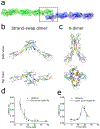Engineering the Interactions of Classical Cadherin Cell-Cell Adhesion Proteins
- PMID: 37459190
- PMCID: PMC10361579
- DOI: 10.4049/jimmunol.2300098
Engineering the Interactions of Classical Cadherin Cell-Cell Adhesion Proteins
Abstract
Classical cadherins are calcium-dependent cell-cell adhesion proteins that play key roles in the formation and maintenance of tissues. Deficiencies in cadherin adhesion are hallmarks of numerous cancers. In this article, we review recent biophysical studies on the regulation of cadherin structure and adhesion. We begin by reviewing distinct cadherin binding conformations, their biophysical properties, and their response to mechanical stimuli. We then describe biophysical guidelines for engineering Abs that can regulate adhesion by either stabilizing or destabilizing cadherin interactions. Finally, we review molecular mechanisms by which cytoplasmic proteins regulate the conformation of cadherin extracellular regions from the inside out.
Copyright © 2023 by The American Association of Immunologists, Inc.
Figures


References
-
- Takeichi M 2022. Cell sorting in vitro and in vivo: How are cadherins involved? Seminars in Cell & Developmental Biology. - PubMed
-
- Gumbiner BM 2005. Regulation of cadherin-mediated adhesion in morphogenesis. Nat. Rev. Mol. Cell Biol 6: 622–634. - PubMed
-
- Nawijn MC, Hackett TL, Postma DS, van Oosterhout AJ, and Heijink IH. 2011. E-cadherin: gatekeeper of airway mucosa and allergic sensitization. Trends Immunol 32: 248–255. - PubMed

